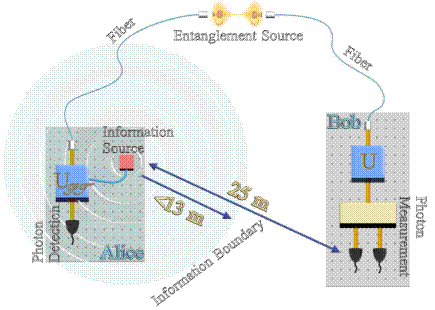Prof. LI Chuan-Feng’s research group from CAS Key Laboratory of Quantum Information in USTC develops a nonlocal quantum simulator and simulates the superluminality phenomenon in parity-time (PT) world. This work for the first time exhibits the important role of nonlocality in quantum simulation, and explores the new direction for the studies of quantum simulator. The paper was published in Nature Photonics on August 8.
Quantum simulator was proposed by Feynman in 1981. Compared to the universal quantum computer, it is used to solve the specialized problems. People usually focus on the capacity of exponential speedup of quantum simulator, whose power exponentially increases as the increase of qubit number. Previous studies suggest that when the number of qubits reaches ~30, the operational capability of quantum simulator can surpass conventional classical quantum computer. To date, the maximal number of qubits that has been experimentally demonstrated is ~10. Nevertheless, this work for the first time reveals another crucial advantage of quantum simulator, namely, the quantum nonlocality. This nonlocal quantum simulator can be used to study some kinds of fundamental physical problems, which can not be solved by the classical computer even in principle.
PT-symmetric theory was suggested by Bender and colleagues to be the complex extension of quantum mechanics in 2002. As we know, quantum mechanics is constructed on a series of postulates. Which of these postulates can be extended? Bender et al. believed that the Hermiticity of the Hamiltonians was too strict, and could be instead of the requirement of PT-symmetry. According to this theory, the usual quantum world is only a special case of the PT world. Li’s group experimentally simulates this PT world. They distribute the entangled photons to two different rooms separated by 25 m to construct the nonlocal quantum simulator. Besides the entangled photon pairs, their quantum simulator is also constituted by a series of quantum logic gates and a post-selection operation. By the post-selection (50% probability to succeed), one of the pair of photons goes through a PT-symmetric evolution. The results of quantum simulation suggest that, utilizing the “spooky action at distance” of the entangled photons, the information can transmit from a room to the other room with a lower bound of speed of 1.9 times of light speed in the simulated PT world. Meanwhile, further experimental results show that, if we consider the total system (i.e., the real world), the information can not transmit faster than light.
This work shows the important role of nonlocal quantum simulator in the studies of fundamental problems on quantum physics, and meanwhile reveals two basic and interesting questions. The first question is whether or not the closed PT-symmetric system exists, which means the possibility of superluminality. The second question is whether there is a more general quantum theory between “the spooky action at distance” and the superluminality.
Link :

Experimental setup

Image for superluminality in PT world